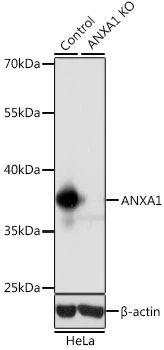Annexin A1 antibody
GTX101070
ApplicationsImmunoFluorescence, ImmunoPrecipitation, Western Blot, ImmunoCytoChemistry, ImmunoHistoChemistry, ImmunoHistoChemistry Paraffin
Product group Antibodies
TargetANXA1
Overview
- SupplierGeneTex
- Product NameAnnexin A1 antibody
- Delivery Days Customer9
- Application Supplier NoteWB: 1:500-1:3000. ICC/IF: 1:100-1:1000. IHC-P: 1:100-1:1000. IP: 1:100-1:500. *Optimal dilutions/concentrations should be determined by the researcher.Not tested in other applications.
- ApplicationsImmunoFluorescence, ImmunoPrecipitation, Western Blot, ImmunoCytoChemistry, ImmunoHistoChemistry, ImmunoHistoChemistry Paraffin
- CertificationResearch Use Only
- ClonalityPolyclonal
- Concentration0.95 mg/ml
- ConjugateUnconjugated
- Gene ID301
- Target nameANXA1
- Target descriptionannexin A1
- Target synonymsANX1, LPC1, annexin A1, annexin I (lipocortin I), annexin-1, calpactin II, calpactin-2, chromobindin-9, epididymis secretory sperm binding protein, phospholipase A2 inhibitory protein
- HostRabbit
- IsotypeIgG
- Protein IDP04083
- Protein NameAnnexin A1
- Scientific DescriptionAnnexin I belongs to a family of Ca(2+)-dependent phospholipid binding proteins which have a molecular weight of approximately 35,000 to 40,000 and are preferentially located on the cytosolic face of the plasma membrane. Annexin I protein has an apparent relative molecular mass of 40 kDa, with phospholipase A2 inhibitory activity. Since phospholipase A2 is required for the biosynthesis of the potent mediators of inflammation, prostaglandins and leukotrienes, annexin I may have potential anti-inflammatory activity. [provided by RefSeq]
- Storage Instruction-20°C or -80°C,2°C to 8°C
- UNSPSC12352203
References
- HA/CD44 Regulates the T Helper 1 Cells Differentiation by Activating Annexin A1/Akt/mTOR Signaling to Drive the Pathogenesis of EAP. Chen J et al., 2022, Front ImmunolRead more
- Phenolic Compounds of Red Wine Aglianico del Vulture Modulate the Functional Activity of Macrophages via Inhibition of NF-kappaB and the Citrate Pathway. Santarsiero A et al., 2021, Oxid Med Cell LongevRead more
- Biomarker discovery in highly invasive lung cancer cell through proteomics approaches. Kuo CH et al., 2021 Apr, Cell Biochem FunctRead more
- Common differentially expressed proteins were found in mouse cleft palate models induced by 2,3,7,8-tetrachlorodibenzo-p-dioxin and retinoic acid. Wang C et al., 2019 Nov, Environ Toxicol PharmacolRead more
- Proteomic and redox-proteomic study on the role of glutathione reductase in human lung cancer cells. Fan CY et al., 2013 Dec, ElectrophoresisRead more
- Hyaluronic acid-dependent protection in H9C2 cardiomyocytes: a cell model of heart ischemia-reperfusion injury and treatment. Law CH et al., 2013 Jan 7, ToxicologyRead more

![IHC-P analysis of human spleen tissue using GTX57177 Annexin A1 antibody [IHC512]](https://www.genetex.com/upload/website/prouct_img/normal/GTX57177/GTX57177_20180619_IHC-P_w_23061123_594.webp)
![ICC/IF analysis of COS7 cells transiently transfected with Annexin A1 plasmid using GTX84886 Annexin A1 antibody [3A8].](https://www.genetex.com/upload/website/prouct_img/normal/GTX84886/GTX84886_1275_ICCIF_w_23061420_614.webp)



